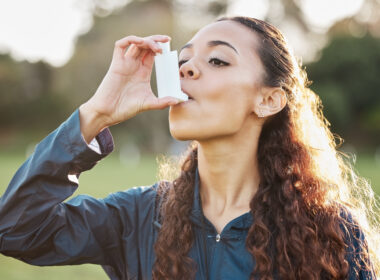As the follow-up to Alisa Vitti’s 2014 bestselling book WomanCode, In the Flo promises to further “break down the four phases of your hormonal cycle, and how they affect your brain, moods, energy, and behaviors” so that readers can “learn how to care for yourself in each unique phase and harness strengths around your creativity, energy, emotions, and sexuality.”
While WomanCode (known popularly as the “purple period bible”) focuses on Vitti’s personal journey of discovery that “you could put your hormonal problems—think PMS, PCOS, fibroids, and endometriosis—into remission naturally with food and diet changes” (p. 4), In the Flo centers on Vitti’s trademarked “Cycle Syncing Method.” Developed from the knowledge she gained on her own journey, and based on the understanding that, while men’s bodies operate on a relatively stable 24-hour clock, women’s bodies actually work on a 28-day cycle, Vitti’s Method centers on teaching women to work with, rather than against, the four phases of their (roughly) 28-day cycle for increased health and overall wellness.
In the Flo explores “a female-centered form of time management that works with your hormonal phases to help you get more done with less stress and get more enjoyment out of everything you do.” Vitti promises that after reading the book and implementing the suggested diet and lifestyle changes, you’ll learn nothing less than how to determine “what day to ask for that promotion, the best time to do yoga or cardio, when to double up on leafy greens, the best week to spend time being introspective and gentle with yourself, and when to unleash your social butterfly.” (p. 5)
Those are tall orders, to be sure! In this review of In the Flo, I hope to give Natural Womanhood readers a better idea of whether this book actually has the potential to deliver on those promises.
Vitti received her undergraduate degree from Johns Hopkins University, though neither In the Flo, nor her website, nor any of the websites on which I read her bio say what she actually studied there. She describes learning on her own about “the endocrine system, epigenetics, circadian patterns of the body and hormones (chronobiology), and the five-phase theory from Chinese medicine,” (p. 31) in an effort to manage her symptoms of polycystic ovary syndrome (PCOS). And, in In the Flo, she wrote “I tapped into my inner strength as a researcher (I had studied biology and wanted to become an OB-GYN).” It is unclear, however, whether Vitti’s degree from Hopkins was science-related.
What is known is that Vitti studied functional nutrition for two years at the Institute for Integrative Nutrition. According to her bio on FloLiving.com, the website for her “virtual online health center to help women solve their hormonal symptoms from anywhere in the world,” Vitti is a “functional nutritionist” and a “women’s hormone expert.”
Who is the intended audience of In the Flo?
Vitti wants every woman of reproductive age to tap into the power of her cycle, and certainly every woman could benefit from some aspect(s) of the book. That said, women who are of reproductive age and currently experiencing hormonal imbalances are most likely to turn towards Vitti’s book and tune in to its message.
What are the main content areas of In the Flo?
In the Flo is broken down into three sections.
Part I: “Our Bodies, Our Time”
In the first section, “Our Bodies, Our Time,” Vitti explores common misconceptions and knowledge gaps that many women have about their own bodies. She also defines and distinguishes between women’s two “clocks,” the Circadian Rhythm (24-hour clock) and the Infradian Rhythm (28-day cycle). Vitti shares a primer on hormones as well as the four phases of the woman’s cycle, and what happens during each. She also includes a fascinating section on how the different phases of the 28-day cycle affect the brain, the immune system, metabolism, the microbiome, and the stress response.
Part II: “Getting Your Body in the Flo”
In the second section, “Getting Your Body in the Flo,” which is significantly longer than the first and third sections, Vitti dishes on what to eat (and not) during each phase of the 28-day cycle, and addresses why dieting is ultimately unsuccessful for many women (Here’s a hint: your nutritional and metabolic needs vary over the course of the four cycle phases!). She also teaches women to “biohack” their cycle to “work out less” but “get more fit” (p. 131) based on which phase they are in.
Vitti’s characteristic assertiveness is on full display in section two, as when she responds to the line of thinking that says women shouldn’t be ‘held back’ by their periods by declaring “the assertion that your period is a liability that you must overcome with willpower is toxic.” She adds “Enforcing a cultural norm—the belief that you should work out no matter how you feel—further forces a woman to practice actively ignoring her inner wisdom and feel disconnected from her body.” Section two also educates women on the problems that arise when they emphasize productivity based on the circadian rhythm without respect to which phase of their Infradian Rhythm they are in. Here, Vitti makes specific recommendations for “managing your creative process according to your cycle.” (p 165)
Section two closes with a lengthy “Biohacking Tool Kit,” which addresses specific hormonal imbalances and reproductive issues, and action items for resolving each. Vitti’s discussion of the harms of birth control in the Tool Kit section is likely to resonate with Natural Womanhood readers in particular.
Part III: “Getting Your Life in the Flo”
Section three, “Getting Your Life in the Flo,” centers on the ways that a woman’s professional work, sex life, and motherhood are impacted by the Infradian Rhythm/28-day cycle, and how women can utilize this knowledge to improve their satisfaction in each area.
Strengths of In the Flo
Vitti’s enthusiasm for her subject and her desire for women’s improved health are obvious, and she takes care to provide academic and research citations throughout the book. While the phases of the woman’s cycle are not new to me, I appreciated Vitti’s attention to detailed instructions about how, for instance, women’s energy levels and nutritional needs change from one phase to the next. Detailed suggestions in each of the main areas—nutrition, sex life, exercise, etc.—were not lacking. I personally was particularly encouraged by her approach to pregnancy and the postpartum period, especially her thoughts on losing baby weight postpartum.
Limitations or blindspots
Many women may find themselves unable to relate to Vitti’s strict adherence to a “textbook definition” of a 28-day cycle. Vitti connects longer or shorter cycles to hormonal imbalances, and certainly this is sometimes the case. Still, evidence-based methods of fertility awareness generally list a wider range of “normal” cycle length, and research suggests that only about 13% of women actually experience a true 28-day cycle.
Personally, I found Vitti’s frequent references to the ubiquitous “patriarchy” as a catch-all scapegoat for every problem facing women, and society at large, to be off-putting. Sweeping generalizations and setting up an us vs. them dichotomy do not serve Vitti or her message well, and cause her to miss the mark when it comes to both men and women’s greatest strength: the capacity for complementary self-gift. Vitti instead repeatedly refers to the need for women to “self-reference” in all things. I agree with the liberating power of listening to our bodies, but in the context of using that knowledge to live lives of contribution—not so we can make ourselves the center of the universe.
Every woman can take something useful from this book to incorporate in her own life, be it nutrition suggestions, a different approach to productivity and work, or following her intuition when it comes to working out in each phase of her cycle. This book did not make a “true believer” out of me (i.e., I’m not convinced I need to sign up for Vitti’s Flo Living programs, or buy her nutritional supplements, etc., to fully benefit from the information found in her book), but overall, I found In the Flo to be helpful as a resource or reference.
The verdict: To buy, borrow, or skip In the Flo altogether?
I borrowed this book from the library, and that’s my recommendation for other women. That said, I took several notes as I was reading for future reference. I am currently pregnant and anticipate borrowing it again for reference when I have my cycle back after baby, as I found her information about weight loss and nutrition during the postpartum time to be the most noteworthy and compelling aspects of the book.
In short, In the Flo is worth a read if you’re someone who’s interested in learning more about how your cycle can impact and inform self-care—but maybe take its suggestions as “more what you’d call ‘guidelines’ than actual rules” (to paraphrase a famous movie quote). And, depending on where you are in your reproductive journey, it may or may not be worth a purchase.








The majority of Americans are unhealthy so we cannot use what is normal as what is ideal. We in medicine forget this too much and don’t understand you can’t compare unhealthy subjects to unhealthy subjects. A good example is 120/80 BP is normal but 115/75 is optimal and associated with lowest morbidity. So when noting that many women have shorter or longer cycles, that doesn’t make it optimal while it may be normal because so many of us are not healthy.